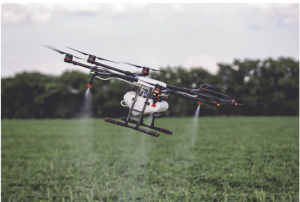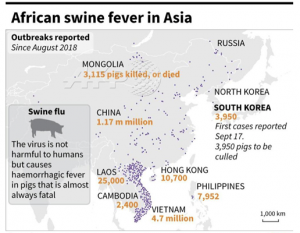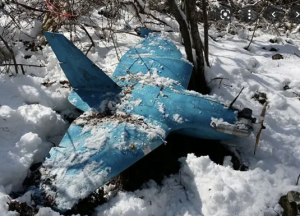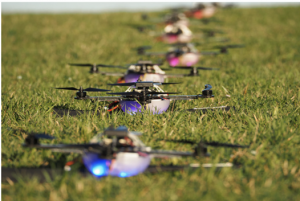3 Biological Weapons
By Dr. Suzanne Sincavage & Professor Candice M. Carter
STUDENT OBJECTIVES
- To further understand the role of unmanned systems in the biological agent realm.
- To study advances in using biological agents with unmanned aerial systems.
- To develop an understanding of how the proliferation of biological attacks via drones is becoming an advanced threat.
INTRODUCTION
Globally, there are well over 50 high containment (Biosafety Level (BSL)-4) laboratories, either in operation or under construction, spread throughout Asia, Africa, Europe, Russia, and the US. These labs carry out some of the most dangerous manipulations of pathogens with pandemic potential. (Lentos & Goodman, 2020) As the enhancements of pathogens rise in danger, delivery methods grow with advancements in technology.
Biological warfare agents are microorganisms like viruses, bacteria, fungi, protozoa, or toxins produced by them that give rise to diseases in man, animals, or plants when deliberately dispersed in an area. (Thavaselvam & Vijayaraghavan, 2010) The continued exploration of detection platforms and detection of bioweapons is vital. The threat of biological warfare agents, their use, and their method of attack delivery are a global concern. Biological attacks can cause a wide scale of casualties and contaminate public areas making the challenge of cleaning up unscalable. In ancient history, the well-known attempt to use biological warfare agents was during the 14th-century medieval siege of Kaffa, Feodosiya, Ukraine. (Thavaselvam & Vijayaraghavan, 2010) In this incident, the Tartars (Mongols) who attacked Kaffa tossed dead and dying plague victims into the city in an attempt to spread the disease. In another well-documented incident at Fort Pitt, Ohio River Valley, the British troops deliberately spread smallpox among the native Indian population by presenting them with blankets and linens used by smallpox victims. (Thavaselvam & Vijayaraghavan, 2010) The importance of biological weapons was significantly advanced in the present century due to several wars and multiple threats. The accidental release of anthrax from a military testing facility in the former Soviet Union in 1979 and possession of anthrax, botulinum toxin, and aflatoxin in Iraq in 1995 point out to research and development of these agents despite the 1972 Biological Weapons Convention. (Thavaselvam & Vijayaraghavan, 2010) The combination of biological weapons and unmanned technology makes the scope of attack limitless. The delivery of a biological agent is, unfortunately, versatile. The agent can be delivered via unmanned missile or large aerial system at a Nation-state level or delivered by an off-the-shelf drone by a terrorist(s) (homegrown or foreign). Due to this type of varied attack, multiple defense options need to be developed to detect, prevent, or assist in cleaning up a biological weapon attack. When technology becomes widely available and less expensive, not to mention remotely operable, it becomes attractive to those with nefarious intent. Add the capability to deliver biological, chemical, and nuclear payloads, and the potential to be used as a Weapon of Mass Destruction by non-state actors becomes a frightening reality. (Nichols, 2020)
TABLE 3.1 Biological Agents that can be used in Biological Warfare

Source: (Thavaselvam & Vijayaraghavan, 2010)
EARLY UNMANNED BIOLOGICAL WEAPON
American companies were expected to help with the U.S. defense department during World War II. Several companies answered the call and helped the military where they could. However, General Mills, the cereal company, really took the idea a step further, perhaps foreshadowing the abilities of the future. General Mills’ first step was the creation of high-altitude reconnaissance balloons. These balloons could take photos of the Soviet Union and collect air samples to test for radioactive isotopes (indicating nuclear weapons testing). (Greenewald, 2020) General Mills suggested releasing biological agents from the balloon deep in enemy territory during the refining of balloon operations. The cereal company could grind fine particles from their cereal development. Unlike the use of an aircraft, the balloon would be able to go deep into a targeted area, avoiding blowback onto U.S. troops. The program went through a series of names as the program evolved, eventually retired as WS-124A, listed as a Weather Reconnaissance Project, a cover story used to shield the aerial biological weapons program. (Greenewald, 2020) This example demonstrates the early exploration of an unmanned aerial system that can go undetected not only for reconnaissance but as a mechanism for the delivery and detection of biological agents.
FIGURE 3.1 Early Unmanned BIOWEAPONS

Source: (Airvector, 2021)
ATTACK
Terrorist Groups
Terrorist groups use drones to gather intelligence on high secure areas; drones are ideal for circumventing defenses. They use cameras with the visual, thermal, and infrared capability to examine their target. For example, terrorists often use consumer drones to see the layout of a secured area (i.e., nuclear plant, military base). Also, the drone allows them to observe the security practices of the facility. This gives an advantage for the attack on facility, personnel, or contents that are being protected. Weaponizing commercially available or building their own to hit targets, terrorists can easily obtain drones that can carry a small payload of a few kilograms to dozens of kilograms onboard. While the ability to carry a biological weapon needs a specialized dissemination device, it is available and can be attached by modifying the drone. Some biological products do not require crystallization for dissemination, such as animal and plant pathogens that an unmodified commercial drone could easily deliver. “If a terrorist group were able to carry out the complex tasks of creating and using biological weapons, an intentional release of a biological weapon could be even more deadly than COVID-19”, said Dr. Goldring, who is also Visiting Professor of the Practice in Duke University’s Washington DC program. (Deen, 2020) “It is not the terrorist groups that are the problem here. It is the terrorist governments like the USA, China, Russia, UK, Israel, etc. that have the most advanced biological warfare facilities and biological weapons in the world that threaten the very existence of all humanity as Covid-19 is now doing, said Professor Boyle professor of international law at the University of Illinois College of Law. (Deen, 2020)
FIGURE 3.2 Spraying Drone

Source: (Lambert C. A., 2020)
In China, gangs use drones to spread African Swine fever to the pig population. The biological weapon has infected, killed, and spread the disease across Asia. The gang by the infected pigs at cost from the farmers then sells the meat as healthy meat and makes a large profit. The gangs are also using misinformation on social media to drive further fear of their biological weapon, forcing the farmers to sell their pigs at a cost even if they are not infected. This attack has caught the eye of al-Qaeda and other terror networks. In January 2017, the Islamic State of Iraq and Syria (ISIS) started using commercial UAS to provide reconnaissance and targeting information against coalition forces5. It began showing interest in conducting UAS-based CBW attacks. (Lambert C. A., 2020)
FIGURE 3.3 African Swine Fever Across Asia

Source: (DeFranco & Giordano, 2020)
For Nation-states, could the advancements in biological weapons phase out nuclear weapons? As COVID-19 has vividly demonstrated, the risk of a catastrophic biological event is magnified by an increasingly interconnected world, challenged by political instability, urbanization, climate change, and new technologies that make it easier, cheaper, and faster to create engineer pathogens. (Nuclear Threat Initiative, 2022) The development of gene editing gains functions capabilities by deliberately creating potential pandemic pathogens in the lab. Items like this and the significant advancement of agricultural drones should cause alarm. China is the leader in commercial UAS. (Lambert L. A., 2020). China’s latest development, Agras MG 1S, is an agriculture octocopter UAS. The Agras MG 1S can carry up to 10kg of fluid spread across 10 acres with one flight. It can spray 60x faster than a manual sprayer. Imagine if this UAS was used for use with a biological weapon? Since the Spanish Emergency Unit used the octocopter to disinfect large outdoor areas during the Covid-19 pandemic, we can almost imagine that. (Silview” Costinescu, 2021)
Democratic People’s Republic of Korea (DPRK) (North Korea)
The DPRK is suspected of not complying with the Biological and Toxin Weapons Convention (BTWC) and the Geneva Protocol. It is believed that the DPRK has continued to develop biological weapons despite committing to the world that they would not. In 2016, South Korea’s Ministry of National Defense (MND) reported to the United States that DPRK is cultivating anthrax and smallpox as biological weapons. By DPRK defector accounts, it is believed DPRK has 13 biological weapons in play. The MND has reported a DPRK uptick in small drones infiltrating the shared border. From initial observations, the drones appear to be surveillance drones. However, through the voices of defectors, the drones have been armed with biological and chemical weapons. The defectors have also witnessed the testing of these weapons on animal populations. (Nuclear Threat Initiative, 2022)
FIGURE 3.4 Democratic People’s Republic of Korea (DPRK) (North Korea) Drone

Source: (Choi, 2017)
DRONE SWARMS
As mentioned in Chapter 5, drone swarms can be defined as “multiple unmanned platforms and/or weapons deployed to accomplish a shared objective, with the platforms and/or weapons autonomously altering their behavior based on communication with one another.” (Kallenborn & Bleek, 2019) Swarms have the potential to significantly improve chemical and biological weapons delivery. Sensor drones could collect environmental data to improve targeting, and attack drones could use this information in the timing and positioning for release, target selection, and approach. (Kallenborn & Bleek, 2019) Swarms make it easier to disperse biological weapons that can hang in the air to be breathed in by humans or animals. Also, pathogens and toxins payload is lighter, and the member of a drone swarm is ideal for this type of attack (i.e., crop dusting drones). The swarms are easier to adjust to weather conditions such as rain and wind speed. Drone swarms also can combine a biological and a conventional weapon attack.
FIGURE 3.5 Swarm of Mass Destruction

Source: (Kallenborn & Bleek, 2019)
DETECTION
The U.S. Department of Defense program Thunderstorm reviews new and emerging technologies and brainstorms how they can be used in warfare (defense and offense). In FY15, Thunderstorm focused on two areas of interest: 1) Chemical and biological detection capabilities deployed on Unmanned Aerial Systems (UAS); 2) Countering the threat of UAS with chemical and/or biological WMD payloads. (Global Biodefense Staff, 2014) The following was a list of requirements from the U.S. Department of Defense:
- A system that is carried in one backpack up to systems carried/deployed from a HUMVEE-sized vehicle
- UAS payloads that can remotely detect and/or collect and transmit chemical and/or biological data to a receiving unit at least 1 kilometer from the sensing location.
- UAS operable by organic Chemical Biological Radiological and Nuclear (CBRN) unit personnel with minimal training and should be able to hover and land at or near the desired survey locations.
- Ground station capability to provide visual displays of the sensing data received from the mobile detection systems.
- Modular payload(s) capable of detecting: Standard G, H, and V series chemical agents in the vapor phase and/or liquid phase on surfaces or aerosolized particles; Chemical agent precursors or degradation products, priority toxic industrial compounds and materials; Biological Warfare Agents (vegetative cells, spores, and toxins); Persistent and natural flora (providing biological surveillance on current and emerging flora).
- Ground stations may utilize autonomous operation (takeoff, navigation, sample detection/collection, and landing) of the UAS utilizing standard geo-referenced satellite imagery that is either pre-loaded or downloaded on-demand from cellular or Wi-Fi networks. The autonomy interface should be simple enough to be learned in one day or less.
- UAS can operate between 0 and 1000 feet above ground level (AGL) and should have a flight time of at least 30 minutes.
- Positional accuracy of UAS should be +/- 10 meters and altitude accuracy within 1 meter.
- Command, Control, Communications, Computers, Collaboration, and Intelligence (C5I) and sensor systems that facilitate rapid detection, identification, and classification of UAS targets;
- Electronic systems that can interdict, defeat, or deny hostile use of UAS.
- Systems are providing the capability to intercept and neutralize the UAS. Both kinetic and non-kinetic solutions are encouraged and should cover both CONUS and OCONUS applications.
(Global Biodefense Staff, 2014) In January 2020, the U.S. Army was selected as the Department of Defense counter small unmanned aerial systems )C-sUAS) executive agent. The U.S. Army will now find joint solutions to counter the threats of small drones however does not include, among other items countering the biological use of UAS. The U.S. Army Chemical Corps and the Functional Area 52 Nuclear and Counterproliferation Officer Branch, in conjunction with the joint CWMD community, should update their training concepts and scenarios to better prepare the joint force for countering and defending against a UAS CBW threat. (Lambert C. A., 2020)
CONCLUSIONS
The evolution of potential biological agents is exponentially growing by the month. Advancements with genes and modifications of past life-threatening diseases are already happening. Drone technology is growing rapidly and becoming a timely issue for everyone. These easy-to-obtain unmanned aerial systems are inexpensive, therefore opening the use of drones to any threat actor, any group, and any military. The combination of biology and UAS is easier than one might think. The threat is real and cannot be ignored by any Nation-state. Understanding how this biological weapon can be developed, produced, and executed is key to understanding how to defend against such an attack. The U.S. does not have a comprehensive national counter unmanned aircraft system (UAS) strategy to deal with the proliferation of intrusive, undetectable, and potentially lethal commercial UAS. (Lambert C. A., 2020)
BIBLIOGRAPHY
Airvector. (2021, August 1). [3.0] Cold War Balloon Flights 1945:1965. Retrieved April 11, 2022, from AirVectors: http://www.airvectors.net/avbloon_3.html.
Choi, D. (2017, March 30). North Korea Reportedly Has a Fleet of 1,000 Drones for Attacks. Retrieved April 11, 2022, from Business Insider: https://www.businessinsider.com/north-korea-drone-attack-2017-3.
Deen, T. (2020, November 20). A Potential Weapon Kills Over 1.5 Million Worldwide –Without a Single Shot Being Fired. Retrieved April 11, 2022, from Global Issues: https://www.globalissues.org/news/2020/11/20/27042.
DeFranco, J., & Giordano, J. (2020, January 24). Dark Side of Delivery: The Growing Threat of Bioweapon Dissemination by Drones. Retrieved April 11, 2022, from Defense IQ: https://www.defenceiq.com/cyber-defence-and-security/articles/the-dark-side-of-delivery-the-growing-threat-of-bioweapon-dissemination-by-drones.
Global Biodefense Staff. (2014, November 3). Thunderstorm: Drones in CBRN Detection and Terrorism. Retrieved April 11, 2022, from Global Biodefense: https://globalbiodefense.com/2014/11/03/thunderstorm-drones-cbrn-detection-terrorism/.
Greenewald, J. (2020, March 31). General Mills and Biological Weapons. Retrieved April 11, 2022, from The Black Vault: https://www.theblackvault.com/documentarchive/general-mills-and-biological-weapons/.
Kallenborn, Z., & Bleek, P. C. (2019, February 14). Drones of Mass Destruction: Drone Swarms and the Future of Nuclear, Chemical, and Biological Weapons. Retrieved April 11, 2022, from War on the Rocks: https://warontherocks.com/2019/02/drones-of-mass-destruction-drone-swarms-and-the-future-of-nuclear-chemical-and-biological-weapons/.
Lambert, C. A. (2020, September 29). The Chemical and Biological Attack Threat of Commercial Unmanned Aircraft Systems. Retrieved April 11, 2022, from Association of the United States Army: https://www.ausa.org/publications/chemical-and-biological-attack-threat-commercial-unmanned-aircraft-systems.
Lambert, L. A. (2020, October). The Chemical and Biological Attack Threat of Commercial Unmanned Aircraft Systems. Retrieved April 11, 2022, from Association of the United States Army: https://www.ausa.org/sites/default/files/publications/SL-20-5-The-Chemical-and-Biological-Attack-Threat-of-Commercial-Unmanned-Aircraft-Systems.pdf.
Lentos, D., & Goodman, M. S. (2020, October 16). BNS0025 Written evidence submitted by Dr. Filippa Lentzos and Professor Michael S. Goodman, King’s College London King’s Coll. Retrieved April 11, 2022, from UK Parliament Committees: https://committees.parliament.uk/writtenevidence/12902/pdf/.
Nichols, R. K. (2020). Counter Unmanned Aircraft Systems Technologies & Operations. Manhattan, KS: www.newprairiepress.org/ebooks/31.
Nuclear Threat Initiative. (2022). Biological – The Nuclear Threat Initiative. Retrieved April 11, 2022, from Nuclear Threat Initiative: https://www.nti.org/area/biological/
Silview” Costinescu, S. `. (2021, June 3). The US ran gruesome bioweapon research in over 25 countries. Wuhan is the tip of an iceberg. Retrieved April 11, 2022, from SILVIEW.media: https://silview.media/2021/06/03/us-ran-grewsome-bioweapon-research-in-over-25-countries-wuhan-tip-of-an-iceberg-ecohealth-alliance-implicated-again/
Thavaselvam, D., & Vijayaraghavan, R. (2010, July 3). Biological warfare agents – PMC. Retrieved April 11, 2022, from NCBI: https://www.ncbi.nlm.nih.gov/pmc/articles/PMC3148622/.

